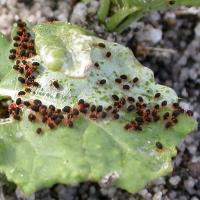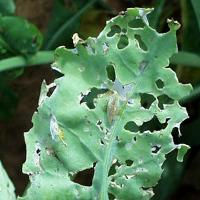Why monitor insects?
Often it may be difficult to identify the insects causing the particular damage. If this is the case, the next option available is to examine the symptoms of crop damage. Use the diagnostic tool (see link below) to help to identify the insect pest causing the damage.
Insects can damage crops throughout the growing season but seedlings and podding crops are most at risk. It is also important to assess any crop damage as soon as it is observed, and determine if further damage is likely to occur. Options available for the control of the particular insect pest can then be explored.
Procedure for monitoring invertebrate pests
There are several methods available for carrying out insect assessments in a crop. These include:
- getting down onto your hands and knees and observing the crop and soil
- Placing traps on the ground for slugs and certain pests like earwings
- using a sweep net
- shaking individual plants onto paper or sheets
- use of an insect trap for monitoring flights of insects at night
The particular method chosen will be influenced by:
- the stage of crop and or insect development
- type of crop being monitored
- the particular pest being monitored
When monitoring pests, it is important to take note of the type of insect, the number of plants affected, the severity of damage to individual crop plants and area of crop affected by the pest. Also when treatment has been applied it is important go back and continue monitoring to ensure it has been successful.
Insect monitoring procedures
Sweep nets
- Sweep nets are suitable for all insect stages except eggs. It is useful for aphids, budworm, pea weevils and other insects found in the crop canopy when the crop is knee high or taller. The standard sweep net is 38 cm in diameter, 70 cm deep with a 120 cm long handle.
- Brush the sweep across the top of the crop canopy in a continuous motion in a 2 m arc. Approximately four sweeps of the net will cover 1 m² of the crop.
Shaking insects off plants
- Place a length of light coloured plastic or equivalent between rows and vigorously shake or beat the plants over the bag. Collect the insects into a container for identification and counting.
- Alternatively, gently pull up the plants and shake or bang into a plastic bucket or sweep net.
Close examination
- This is necessary when assessing small insects, especially those that live on or near the ground. It is useful for insects such as red-legged earth mites, webworm, aphids and vegetable weevils. You may need to crawl around looking at the base of plants and among leaf litter. A warm sunny afternoon is often the best time. A magnifying glass may assist.
- Some pests are difficult to find, especially those that attack plant roots, so it is important to check below as well as above ground during your assessment. Some only emerge at night and require observation then, a pit trap or a cover such as a bag placed on the ground for them to shelter under when daylight.
Interpreting the results
If insects are identified, determine whether or not the crop is likely to suffer further economic damage. When deciding whether the pest should be controlled take into consideration factors such as:
- the stage of crop development
- the stage of insect development
- potential for crop yield/income loss
- other environmental conditions (which are likely to influence pest survival)
- level of predators/parasites present
- cost of control
Insect threshold levels
Check pest numbers with the threshold levels for the crops below:




